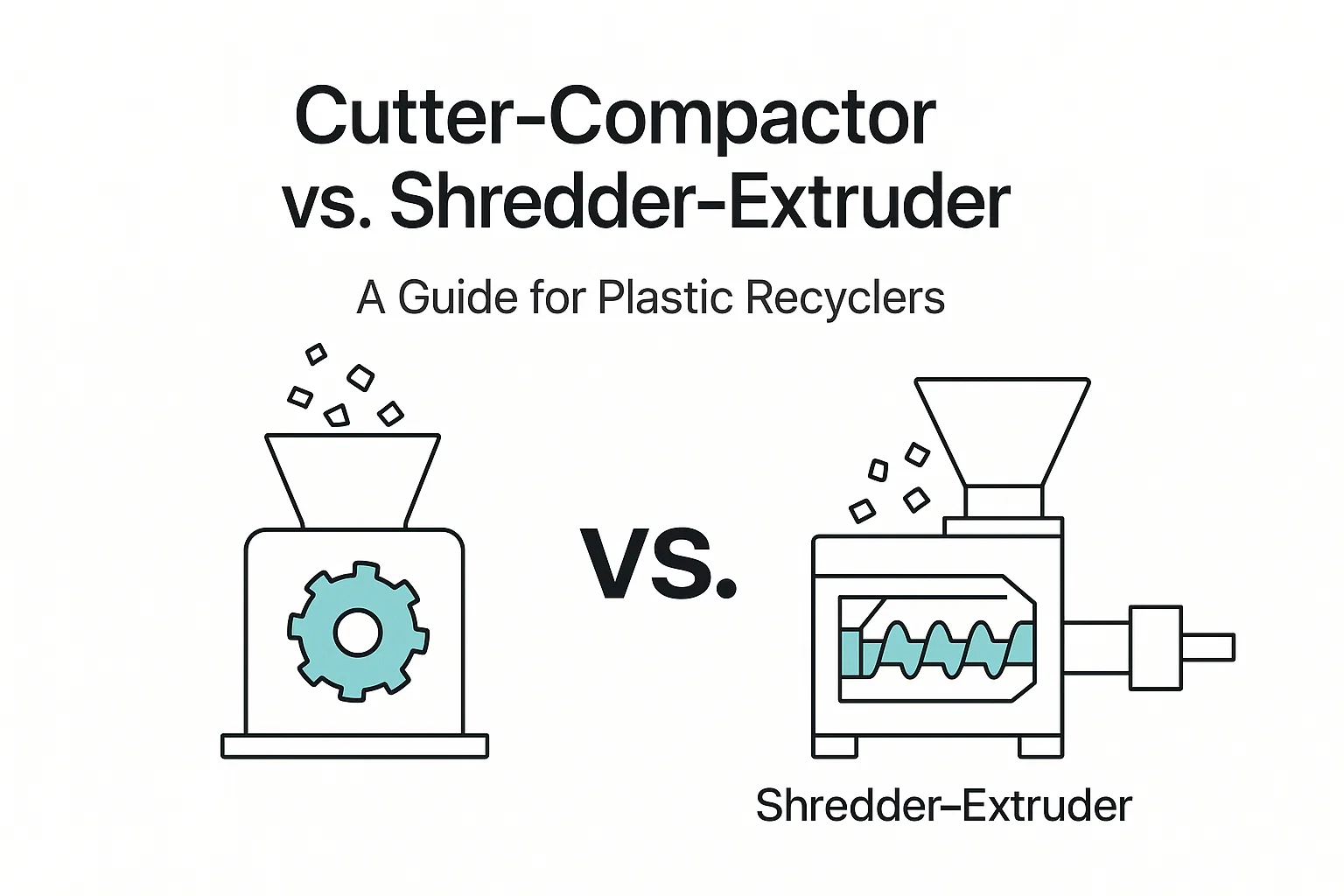Cutter-Compactor vs. Shredder-Extruder: A Guide for Plastic Recyclers
Choosing between a cutter-compactor and a shredder-extruder system is a critical decision for any business recycling soft plastics. Materials like LDPE film, stretch wrap, and PP woven bags are notoriously difficult to process. Their low bulk density and fluffy nature make them challenging to feed consistently into an extruder. This guide provides a clear, technical comparison to help purchasing managers and plant operators select the right integrated system for their specific needs.
We will examine how each system works, compare them across key performance metrics, and provide a framework to help you make a sound investment. Your choice will directly impact your operational efficiency, energy costs, and the quality of your final recycled pellets.

Understanding the Core Challenge: Low Bulk Density
Before comparing the machines, we must understand the problem they solve. A pile of loose plastic film is mostly air. This low bulk density makes it inefficient to handle and nearly impossible for a standard extruder screw to “grab” and process. Both the cutter-compactor and the shredder-extruder are designed to solve this fundamental feeding problem, but they do so in very different ways.
A Detailed Look at the Cutter-Compactor System
A cutter-compactor system, sometimes called an agglomerator-extruder line, is a highly integrated, single-stage solution. It combines material sizing, densification, and extrusion into one continuous process within a single machine.
How it Works:
- Feeding: Soft plastics are conveyed directly into a large drum, the cutter-compactor.
- Cutting and Densifying: High-speed rotating blades at the bottom of the drum instantly cut the material. The intense friction generated by this action heats the plastic to just below its melting point. This causes the material to soften, shrink, and agglomerate into dense, popcorn-like crumbs.
- Direct Extrusion: These hot, densified crumbs are then fed directly and tangentially into the extruder screw. Because the material is already hot and dense, the extruder can process it very efficiently with minimal energy loss.
Think of it as a powerful blender and a gentle cooker combined. It prepares the material perfectly for the extruder in one swift step.
A Detailed Look at the Shredder-Extruder System
A shredder-extruder system is a two-stage solution. It consists of two separate machines linked by a conveyor belt system.
How it Works:
- Shredding: The raw plastic material is first loaded into a large, powerful shredder. The shredder uses a slow-speed, high-torque rotor to tear the material into smaller, more uniform pieces, typically around 20-40mm in size.
- Conveying: These shredded pieces are then transported via a conveyor belt to the hopper of the extruder.
- Extrusion: A force-feeder on the extruder hopper helps push the lighter plastic flakes into the screw. The extruder then melts, mixes, and pressurizes the material to form pellets, just as in the other system.
This method is more modular. It separates the size reduction step from the extrusion step.
Head-to-Head Comparison: Cutter-Compactor vs. Shredder-Extruder
This table breaks down the key differences to guide your decision making process.
| Factor | Cutter-Compactor System | Shredder-Extruder System |
|---|---|---|
| Footprint & Layout | Compact and integrated. Requires less floor space as it is a single unit. | Larger and modular. Requires more floor space for the shredder, conveyor, and extruder. |
| Energy Consumption | More energy-efficient. Friction from cutting pre-heats the material, reducing the extruder’s energy load. | Less energy-efficient. The shredder and extruder are two separate power draws, and the material is fed cold into the extruder. |
| Material Suitability | Excellent for clean, uniform soft plastics like post-industrial film, bags, and stretch wrap (LDPE, LLDPE, PP). | More versatile. Can handle a wider range of materials, including rigid plastics, and is more tolerant of some contamination. |
| Handling Contamination | Less tolerant. Hard contaminants (metal, stones) can damage the high-speed blades. Best for pre-sorted, clean material. | More robust. Slow-speed shredders are better equipped to handle occasional hard contaminants without catastrophic failure. |
| Maintenance & Operation | Simpler operation. Fewer components to manage. Blades require regular sharpening or replacement. | More complex. Two separate machines to operate and maintain. Shredder blades are durable but costly and time-consuming to replace. |
| Final Pellet Quality | Often higher quality. The gentle heating process minimizes thermal degradation, preserving the polymer’s properties. | Good quality, but the two-stage process can introduce more heat history, potentially leading to slight material degradation. |
| Capital Investment | Generally lower initial investment due to its integrated design. | Generally higher initial investment due to the cost of two separate, heavy-duty machines. |
How to Choose the Right System for Your Operation
The best choice depends entirely on your feedstock and business goals. Use these points as a decision-making guide.
Choose a Cutter-Compactor System if:
- Your primary feedstock is clean, post-industrial film or bags.
- Energy efficiency and a smaller footprint are top priorities.
- You value lower initial capital investment and simpler operation.
- Maximizing the quality and integrity of the recycled polymer is crucial.
Choose a Shredder-Extruder System if:
- Your feedstock is mixed, may contain some rigid plastics, or has a higher chance of contamination (e.g., post-consumer waste).
- You need a highly versatile line that can process a wide variety of plastic forms.
- You have ample floor space and a larger initial budget.
- Your operational focus is on robustness and handling difficult input materials.
For more information on plastic types and their properties, resources from the Plastics Industry Association can be very helpful.
The Energycle Machine Advantage in Compaction Technology
At Energycle Machine, we focus on engineering excellence for efficient recycling. Our cutter-compactor recycling granulating line is a perfect example of this philosophy. It is designed to deliver high output with low energy consumption, making it an ideal solution for businesses focused on processing clean film and bag waste. The integrated design simplifies operation and reduces the total cost of ownership, providing a faster return on your investment.
Frequently Asked Questions (FAQ)
Can a cutter-compactor handle wet material?
While some moisture is tolerated, very wet material is problematic. The heat from the compactor will create steam, which can cause voids in the final pellets. The material should be as dry as possible for best results.
What is the typical output of these lines?
Output varies widely based on machine size and material type. Commercial lines can range from 100 kg/hr for smaller models up to 1000 kg/hr or more for large industrial installations.
Which system is better for post-consumer film?
This is a complex question. If the post-consumer film is relatively clean after washing, a cutter-compactor can work well. However, if it contains significant non-plastic contamination, a shredder-extruder line is generally the more forgiving and robust choice.
Conclusion: A Strategic Choice Based on Your Feedstock
The debate between a cutter-compactor and a shredder-extruder is not about which is universally better, but which is strategically right for your specific application. The cutter-compactor offers unmatched efficiency for clean, soft plastics in a compact, cost-effective package. The shredder-extruder provides versatility and robustness for more varied or contaminated waste streams. By carefully analyzing your feedstock, operational goals, and budget, you can confidently select the system that will become a profitable cornerstone of your recycling operation.



